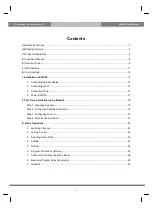
En
2
The emphasis in designing this software has been on achieving
portability and flexibility, while also making it fast enough to be
useful. In particular, the software is not intended to be read as a
tutorial on JPEG. (See the REFERENCES section for introductory
material.) Rather, it is intended to be reliable, portable, industrial-
strength code. We do not claim to have achieved that goal in every
aspect of the software, but we strive for it.
We welcome the use of this software as a component of
commercial products.
No royalty is required, but we do ask for an acknowledgement in
product documentation, as described under LEGAL ISSUES.
LEGAL ISSUES
In plain English:
In legalese:
The authors make NO WARRANTY or representation, either
express or implied, with respect to this software, its quality,
accuracy, merchantability, or fitness for a particular purpose. This
software is provided “AS IS”, and you, its user, assume the entire
risk as to its quality and accuracy.
This software is copyright
©
1991-2010, Thomas G. Lane, Guido
Vollbeding.
All Rights Reserved except as specified below.
Permission is hereby granted to use, copy, modify, and distribute
this software (or portions thereof) for any purpose, without fee,
subject to these conditions:
(1) If any part of the source code for this software is distributed,
then this README file must be included, with this copyright and
no-warranty notice unaltered; and any additions, deletions, or
changes to the original files must be clearly indicated in
accompanying documentation.
(2) If only executable code is distributed, then the accompanying
documentation must state that “this software is based in part on the
work of the Independent JPEG Group”.
(3) Permission for use of this software is granted only if the user
accepts full responsibility for any undesirable consequences; the
authors accept NO LIABILITY for damages of any kind.
These conditions apply to any software derived from or based on
the IJG code, not just to the unmodified library. If you use our
work, you ought to acknowledge us.
Permission is NOT granted for the use of any IJG author’s name or
company name in advertising or publicity relating to this software
or products derived from it. This software may be referred to only
as “the Independent JPEG Group’s software”.
We specifically permit and encourage the use of this software as
the basis of commercial products, provided that all warranty or
liability claims are assumed by the product vendor.
ansi2knr.c is included in this distribution by permission of L. Peter
Deutsch, sole proprietor of its copyright holder, Aladdin
Enterprises of Menlo Park, CA.
ansi2knr.c is NOT covered by the above copyright and conditions,
but instead by the usual distribution terms of the Free Software
Foundation; principally, that you must include source code if you
redistribute it. (See the file ansi2knr.c for full details.) However,
since ansi2knr.c is not needed as part of any program generated
from the IJG code, this does not limit you more than the foregoing
paragraphs do.
The Unix configuration script “configure” was produced with
GNU Autoconf. It is copyright by the Free Software Foundation
but is freely distributable. The same holds for its supporting scripts
(config.guess, config.sub, ltmain.sh). Another support script,
install-sh, is copyright by X Consortium but is also freely
distributable.
The IJG distribution formerly included code to read and write GIF
files. To avoid entanglement with the Unisys LZW patent, GIF
reading support has been removed altogether, and the GIF writer
has been simplified to produce “uncompressed GIFs”. This
technique does not use the LZW algorithm; the resulting GIF files
are larger than usual, but are readable by all standard GIF decoders.
We are required to state that
“The Graphics Interchange Format
©
is the Copyright property of
CompuServe Incorporated. GIF(sm) is a Service Mark property of
CompuServe Incorporated.”
REFERENCES
We recommend reading one or more of these references before
trying to understand the innards of the JPEG software.
The best short technical introduction to the JPEG compression
algorithm is
Wallace, Gregory K. “The JPEG Still Picture Compression
Standard”, Communications of the ACM, April 1991 (vol. 34 no.
4), pp. 30-44.
(Adjacent articles in that issue discuss MPEG motion picture
compression, applications of JPEG, and related topics.) If you
don’t have the CACM issue handy, a PostScript file containing a
revised version of Wallace’s article is available at
http://www.ijg.org/files/wallace.ps.gz.
The file (actually a preprint for an article that appeared in IEEE
Trans. Consumer Electronics) omits the sample images that
appeared in CACM, but it includes corrections and some added
material. Note: the Wallace article is copyright ACM and IEEE,
and it may not be used for commercial purposes.
1.
We don’t promise that this software works. (But if you find
any bugs, please let us know!)
2.
You can use this software for whatever you want. You don’t
have to pay us.
3.
You may not pretend that you wrote this software. If you use
it in a program, you must acknowledge somewhere in your
documentation that you’ve used the IJG code.
Continues to the
next page
Содержание RX-A1000
Страница 1: ...Owner s Manual AV Receiver English for U S A ...
Страница 158: ... 2010 Yamaha Corporation YC711B0 OMEN1 ...
Страница 175: ...AV Receiver English Safety Brochure ...
Страница 179: ... 2010 Yamaha Corporation YC712A0 SBEN ...




































